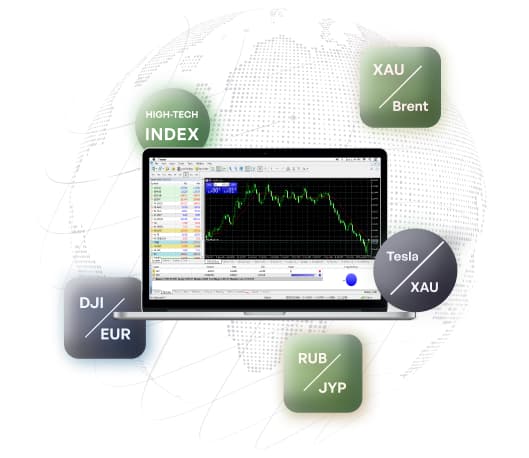- Trading
- Markets
- Synthetic Instruments Library
Library of Synthetic Instruments
The Library of Synthetic Instruments offers traders innovative ways to access global markets using specially designed instruments created by analysts at IFC Markets.
These instruments, known technically as Personal Composite Instruments (PCI), are available for trading in the NetTradeX platform.
Synthetic instruments combine data from multiple assets, such as commodities, indices, and currencies, to create tradable products that replicate real market behavior.

For trading the chosen PCI the user should do the following:
- Install NetTradeX trading platform on your computer and open an account in the trading platform
- Click "Download" button on the line of the chosen PCI
Please, study the instruction on using Synthetic Instruments and the additional instruction on working with Synthetic Instruments Library.
Looking for a Trading Instrument?
Please, choose the account type on NetTradeX platform
Synthetic Instruments Trading
Synthetic instruments trading allows you to trade combinations of assets in one instrument, giving exposure to multiple markets simultaneously. Each PCI is created to reflect the movement of its underlying components.
For example, a synthetic instrument might combine gold and oil prices, or a currency basket. Traders can go long if they expect the synthetic instrument’s value to increase or short if they anticipate a decline. Synthetic instruments trading provides access to markets that may otherwise be difficult to trade directly.
What are Synthetic Instruments?
Synthetic instruments are financial products designed to replicate the behavior of one or more underlying markets. Each instrument has a defined structure and reflects price movements from its components, which can include commodities, indices, or currencies.
For instance, the &XAUJPY PCI tracks the combination of gold and Japanese yen movements, allowing traders to speculate on this relationship without holding actual gold or yen. Similarly, an instrument like &SumOIL/GAS reflects a combination of Brent oil and natural gas prices.
Synthetic instruments can be especially useful for traders who want to:
- Access multiple markets in one instrument
- Trade assets that may not be directly available
- Use predictable pricing patterns for analysis and strategy

How to Trade Synthetic Instruments?
Trading synthetic instruments in NetTradeX is simple and follows these steps:
- Install NetTradeX – Download the platform to your PC and open an account./li>
- Select a synthetic instrument – Choose a PCI from the library that matches your trading strategy.
- Download the instrument – Click the “Download” button on the PCI line in the platform.
- Analyze and decide on direction – Go long if you expect the instrument’s price to rise or short if you expect it to fall.
- Set position size and risk controls – Determine your volume, leverage, and use stop-loss/take-profit orders.
- Monitor and manage your trade – Track market news and price changes of the instrument’s underlying components.
- Close your position – Realize profits or limit losses based on your trading plan.
Suppose a trader selects &BRENT/EUR, which combines Brent oil futures with the Euro. If oil prices rise while the Euro remains stable, the synthetic instrument’s price increases, allowing the trader to profit from a long position.

Key Benefits of Synthetic Instruments Trading
Trading synthetic instruments comes with several advantages.
- Access to unique instruments – Trade combinations of commodities, indices, and currencies not available elsewhere.
- Flexible trading hours – Many synthetic instruments are available during extended hours.
- Diversification – Gain exposure to multiple assets in one trade.
- Simplified market access – No need to manage multiple underlying assets separately.
- Leverage opportunities – Increase potential returns with smaller capital.
- Hedging potential – Protect other positions using synthetic instruments to offset market risks.
If a trader who holds stocks sensitive to oil prices could hedge their portfolio by trading a synthetic instrument combining oil and energy stock indices.

More Markets to Consider
Synthetic instruments trading involves speculating on instruments created from multiple underlying assets, such as commodities, indices, or currencies. Traders profit by predicting the price movement of the synthetic instrument.
Synthetic instruments work by combining data from different assets to form a tradable product. For example, a PCI may reflect movements in gold and oil prices. Traders can take long positions if they expect the price to rise or short positions if they anticipate a fall. The NetTradeX platform provides tools to download, trade, and monitor these instruments easily.

